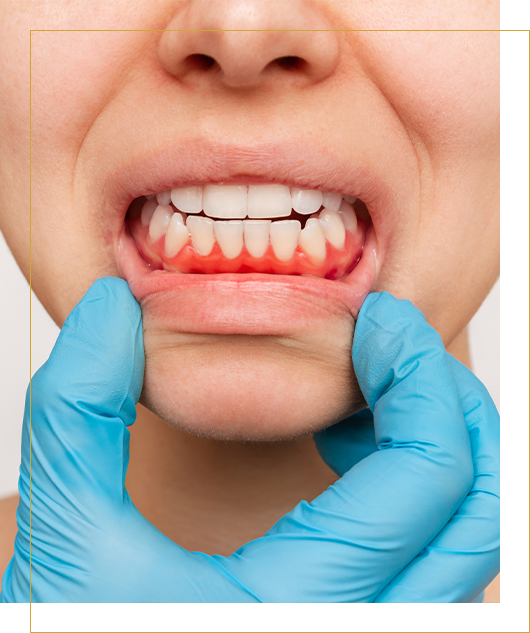Gum Disease Treatment in Mundaring
You deserve the best of everything, and we’re committed to providing it! Leave your dental concerns behind while you receive our high-quality gum disease treatment, which gives a stunning smile without any restrictions.


Get your smile back in perfect shape with effective gum disease treatment
Gum disease is a widespread problem, and it can lead to more severe health problems if it’s not managed.
Gum disease is caused by plaque, which is a film of bacteria that forms on your teeth. If you don’t remove plaque regularly, it can harden into tartar, which is much harder to remove. Plaque and tartar can irritate your gums and cause them to become inflamed. At Mundaring Dental Centre, we offer gentle and effective treatment for gum disease, from mild gingivitis to more severe periodontitis. We’ll help you get your smile back in perfect shape so that you can feel confident about your teeth again. Call us at 08 6495 2000 to make an appointment now!
Problems that Gum Disease Treatment Can Manage

Other Health-related Conditions: It’s never too late to get your gum disease in check, as it has been linked to a range of other diseases. Get treatment from a qualified professional who can help put any concerns at ease and offer treatment options tailored specifically for your needs.
Tooth Loss: Gum disease can be excruciating and can cause you to lose your teeth if it’s not managed immediately. At Mundaring Dental & Implant Centre, we offer gum disease treatment that has been proven to be both practical and affordable.

Why choose
Mundaring dental
& implant centre

Convenient Quality Dental Care
With over 50 years of combined experience, our team of professionals continues to provide high-quality dental services, from general dentistry and dental implant services to restorative and cosmetic dentistry.

A Compassionate Team Utilizing Modern Technology:
Mundaring Dental & Implant Centre offers the latest dental implant technology and techniques to provide you with the best possible results. Our state-of-the-art equipment makes your dental implant experience as easy and stress-free as possible.

Easily Accessible
Mundaring Dental & Implant Centre is proud to offer flexible payment plan options to make sure that everyone receives the dental care they need.

Same-day Dentistry and Fast Turn Around Time
Mundaring Dental & Implant Centre offers same-day service for various dental treatments, including dental crowns. You can get high-quality dental care and more natural-looking crowns in just one visit!
FAQs
Gum disease is caused primarily by plaque. Several factors, however, can influence gum disease. Here are a few of them:
Hormonal shifts: Gums become more sensitive during pregnancy, puberty, menopause, and monthly menstruation, making gingivitis more prone to developing.
Illnesses: Gum disease can be aggravated by illness. This covers disorders that affect the immune system, such as cancer or HIV. Patients with diabetes are at an increased risk of acquiring infections, such as periodontal disease and cavities since diabetes disrupts the body’s ability to use blood sugar.
Medications: Some medications can impact oral health since some reduce saliva flow, which protects teeth and gums. A few medications, including the anticonvulsant Dilantin and the anti-angina medicines Procardia and Adalat, can promote irregular gum tissue growth.
Tobacco chewing and smoking: Smoking impacts the function of gum tissue cells, leaving your mouth vulnerable to infections such as gum disease. Tobacco chewing isn’t much better. Smoking makes gum tissue healing more difficult.
Poor oral health habits: Gum disease is easier to form if you don’t brush and floss daily.
Family history of dental disease: The development of gum disease might be influenced by a family history of dental disease.
Gum disease progresses in three stages:
Gingivitis:
This is the first stage of gum disease, characterized by gum inflammation driven by plaque buildup at the gumline. When plaque is not removed by brushing and flossing daily, it releases toxins (poisons) that damage gum tissue and results in gingivitis. During brushing and flossing, you may detect some blood. Damage can be repaired at this early stage of gum disease because the bone and connective tissue supporting the teeth are not yet impacted.
Periodontitis:
The supporting bone and fibres that hold your teeth in place are irreversibly broken at this point. Your gums may form a pocket below the gum line, trapping food and plaque. In most cases, proper dental care and improved home care can help prevent future long term damage.
Advanced Periodontitis:
The fibres and bone that support your teeth are damaged in this stage of gum disease, which can cause your teeth to shift or loosen. This can impact your bite, and if intensive therapy is unsuccessful, teeth may need to be extracted.
Even in the late stages of gum disease, the disease can develop smoothly with few visible symptoms. Although gum disease signs are generally mild, the condition is not without warning signals. Specific indicators may indicate the presence of the disease. These can include:
- Bleeding gums during and after tooth brushing.
- The gums are red and swollen. Healthy gums should be pink and firm.
- Unpleasant breath or a bad taste in the mouth that persists.
- Gums that are receding.
- Deep pockets between the teeth and gums.
- Teeth that are loose or moving.
- Changes in the fit of partial dentures or the way teeth fit together while biting down
Even if you don’t experience any symptoms, you could still have gum disease. Gum disease may damage only a few teeth in certain people, such as the molars. Only a dentist can detect and monitor the progression of gum disease.
The treatment options for gum disease will depend on your stage of disease, your response to previous treatments, as well as your overall health. Treatments range from non-surgical therapies that control bacterial growth to surgery to restore supportive tissues.
Non-surgical Treatments for Gum Disease
Gum disease can be managed non-surgically in several ways:
Professional dental cleaning
During a routine checkup, your dentist will remove plaque and tartar (plaque that builds up and hardens on the tooth surface and can only be eliminated with professional cleaning) from all teeth above and below the gum line.
If you show signs of gum disease, your dentist may advise you to undergo a professional dental cleaning more than twice a year. Active gum disease cannot be managed with dental cleanings. They are, nonetheless, a crucial preventive strategy that can assist you in preventing its development.
Scaling and root planing
This is a non-surgical, effective cleaning technique performed under local anesthesia in which plaque and tartar from above and below the gum line are scraped away (scaling), and rough places on the tooth root are smoothed (planing). Smoothing the rough places removes bacteria and provides a clean surface for the gums to reconnect with the tooth. If your dentist finds that you have plaque and calculus (hardened plaque, also known as tartar) behind your gums that needs to be removed, scaling and root planing are performed.
Surgical Treatments for Gum Disease
In some cases, gum disease requires surgical treatment. These treatments include:
Flap surgery/pocket reduction surgery
The gums are lifted back, and tartar is removed during this procedure. In other situations, the damaged bone’s uneven surfaces are smoothed to restrict the locations where disease-causing bacteria can lurk. The gums are then positioned so that they fit tightly around the tooth. This treatment minimises the amount of space between the gums and the teeth, reducing the places where harmful bacteria can thrive and the possibility of significant health problems connected with periodontal disease.
Bone grafts
This technique involves replacing bone damaged by gum disease with fragments of your bone, synthetic bone, or donated bone. The grafts act as a platform for bone development, restoring tooth stability. Tissue engineering is a new technology that stimulates your body to rebuild bone and tissue faster.
Soft tissue grafts
This procedure strengthens weak gums or fills gaps where gums have receded. Grafted tissue, usually taken from the roof of the mouth, is stitched into place, adding tissue to the damaged area.
Guided tissue regeneration
This treatment stimulates bone and gum tissue development after the bone supporting your teeth has been removed. A thin piece of mesh-like material is put between the bone and gum tissue in conjunction with flap surgery. This stops the gum tissue from growing into the bone’s place, allowing the bone and connective tissue to rebuild and better support the teeth, so that they can stay in place better.
Bone surgery
It works by decreasing the number of shallow craters in the bone caused by mild to advanced bone loss. The bone around the tooth is modified after flap surgery to reduce craters. This makes it more difficult for bacteria to gather and flourish.
For some patients, scaling and root planing are needed to manage gum disease. However, when the tissue around a tooth is unhealthy and cannot be managed without surgery, it needs to be surgically repaired.
Gum disease is entirely preventable. Here are a few tips for maintaining healthy gums.
1. Use a floss.
Floss your teeth at least once a day. This aids in the removal of plaque and food that is beyond the reach of your toothbrush.
2. Have your teeth cleaned regularly.
If you visit your dentist regularly, the dentist will be able to spot early signs of gum disease. A professional cleaning may only remove tartar. It can also remove any plaque that you missed while brushing or flossing. Brushing, flossing, and frequent dental cleanings can help reverse gingivitis.
3. Give up smoking.
Another reason for smokers to quit: smoking is highly linked to the development of gum disease. Furthermore, smoking makes it more difficult for damaged gums to heal.
4. Brush your teeth twice a day.
After each meal, brush your teeth. This assists in the removal of food and plaque that have become stuck between your teeth and gums. Scrub your tongue as well, as it might collect bacteria.
5. Make use of fluoride toothpaste.
Make sure to use fluoride-containing toothpaste with a reliable mark of approval.
6. Use a therapeutic mouthwash.
Therapeutic mouthwashes, typically available over the counter, can help decrease plaque, prevent or minimize gingivitis, slow the formation of tartar, or combine these advantages. Furthermore, rinsing promotes the removal of food particles and debris from your mouth, but it is not a replacement for flossing or brushing.
Cleanings should be scheduled once or twice a year for the average person. However, if you have gum disease, you will need to schedule cleanings more frequently than twice a year. Your dentist may advise you to visit more frequently, perhaps every three to four months, to avoid the advancement of gum disease and further damage.
